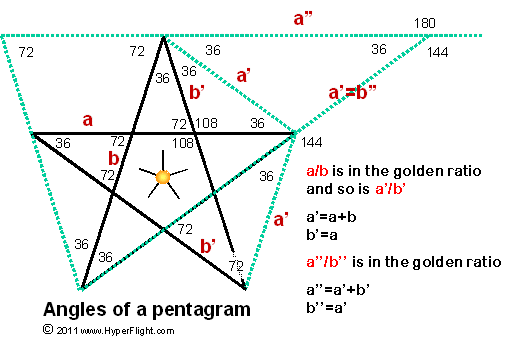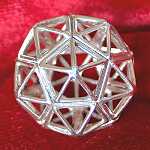|
|
General: LA RAZON EN LA BIBLIA TAMBIEN ES UNA FORMA DE LLEGAR A LA VERDAD
Choisir un autre rubrique de messages |
|
Réponse |
Message 1 de 273 de ce thème |
|
|
|

ROMANOS 1
21. Pues habiendo conocido a Dios, no le glorificaron como a Dios, ni le dieron gracias, sino que se envanecieron en sus razonamientos, y su necio corazón fue entenebrecido.
22. Profesando ser sabios, se hicieron necios,
23. y cambiaron la gloria del Dios incorruptible en semejanza de imagen de hombre corruptible, de aves, de cuadrúpedos y de reptiles.
24. Por lo cual también Dios los entregó a la inmundicia, en las concupiscencias de sus corazones, de modo que deshonraron entre sí sus propios cuerpos,
25. ya que cambiaron la verdad de Dios por la mentira, honrando y dando culto a las criaturas antes que al Creador, el cual es bendito por los siglos. Amén.
26. Por esto Dios los entregó a pasiones vergonzosas; pues aun sus mujeres cambiaron el uso natural por el que es contra naturaleza,
27. y de igual modo también los hombres, dejando el uso natural de la mujer, se encendieron en su lascivia unos con otros, cometiendo hechos vergonzosos hombres con hombres, y recibiendo en sí mismos la retribución debida a su extravío.
28. Y como ellos no aprobaron tener en cuenta a Dios, Dios los entregó a una mente reprobada, para hacer cosas que no convienen;
29. estando atestados de toda injusticia, fornicación, perversidad, avaricia, maldad; llenos de envidia, homicidios, contiendas, engaños y malignidades;
30. murmuradores, detractores, aborrecedores de Dios, injuriosos, soberbios, altivos, inventores de males, desobedientes a los padres,
31. necios, desleales, sin afecto natural, implacables, sin misericordia;
32. quienes habiendo entendido el juicio de Dios, que los que practican tales cosas son dignos de muerte, no sólo las hacen, sino que también se complacen con los que las practican.
|
|
|
|
|
|
|
Réponse |
Message 139 de 273 de ce thème |
|
|
|
|
Réponse |
Message 140 de 273 de ce thème |
|
|
|
|
Réponse |
Message 141 de 273 de ce thème |
|
From high atop a column the symbol of Venice, the winged lion of St. Mark, greets visitors to Piazza San Marco.
|
|
|
The Lion, Campanile and Doge's Palace
|
The square's original bell tower, or campanile, collapsed in 1902 but was rebuilt.
 |
| The Campanile |
Across from the campanile is the Palazzo Ducale, or the Palace of the Doges, built of pink and white limestone in the Venetian Gothic style .
 |
| Doge's Palace, Venice |
A wide promenade, the Riva degli Schiavoni, runs along the water's edge from the Doge's Palace to the Arsenal, the shipbuilding yards of Venice.
 |
| Gondolas on the Riva degli Schiavoni |
A stroll along the promenade takes you past the Vitorrio Emmanuel II monument.
 |
| Vittorio Emanuel II Monument |
The Tourist, a 2010 movie starring Johnny Depp and Angelina Jolie, was filmed at the nearby Hotel Danieli.
 |
| Floral Display at the Hotel Danieli |
If you encounter a crowd atop a small bridge, they have stopped to admire Il Ponte dei Sospiri, or the Bridge of Sighs.
 |
Bridge of Sighs
|
The bridge was named by Lord Byron for the sighs of prisoners as they took their last look at freedom, and the beauty of Venice, before being led to the Doge's prison. Giacomo Casanova was the prison's most famous captive - and he managed to escape.
 |
The Doge's Prison
|
Beyond Venice in the lagoon, the island of Murano is famous for its glass blowing factories. The factories were located outside of Venice to protect the population from the dangers of fire, and also to protect the glass makers' secrets.
 |
The Island of Murano
|
 |
The Lighthouse of Murano
|
 |
| The Art of Glass Blowing |
Back at Piazza San Marco, Robert Langdon approaches the basilica of St. Mark's.
 |
Piazzetta di San Marco
|
 |
| St. Mark's Basilica |
Another lion keeps watch from St. Mark's Clock Tower.
 |
St. Mark's Clock Tower
|
 |
| Astronomical Clock |
Beneath the Clock Tower is an archway which leads to the Mercerie, the main shopping street of Venice that runs between Piazza San Marco and the Rialto Bridge.
 |
| Clock Tower Archway |
On the central peak of the basilica, a statue of St. Mark stands over the bronze horses looted from Constantinople during the Crusades. Centuries later, Napoleon sent the horses to Paris to sit on top of the Arc de Triomphe. The original horses are now inside the basilica - the ones outside are copies.
 |
The Domes of St. Mark's
|
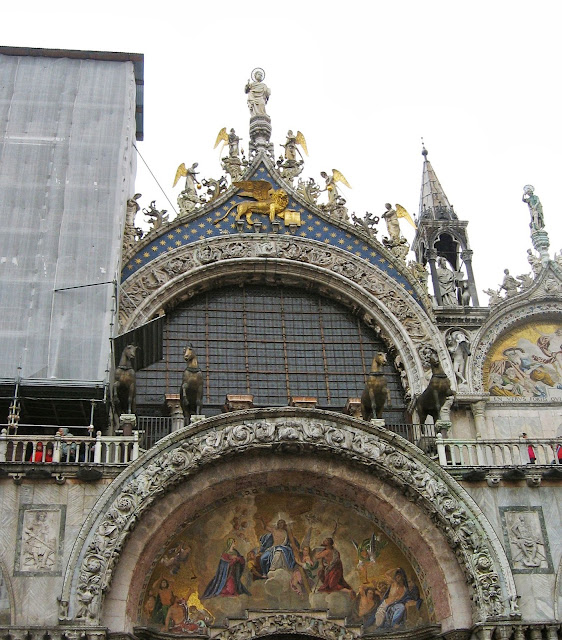 |
Statue of St. Mark
|
 |
The Horses of St. Mark's
|
 |
| The Winged Lion of St. Mark |
|
|
|
|
https://destinationfiction.blogspot.com.ar/2013/05/dan-browns-inferno-venice-in-photos.html
|
|
|
|
|
|
Réponse |
Message 142 de 273 de ce thème |
|
|
|
|
Réponse |
Message 143 de 273 de ce thème |
|
|
|
|
Réponse |
Message 144 de 273 de ce thème |
|
|
|
|
Réponse |
Message 145 de 273 de ce thème |
|
|
EN LA BIBLIA TODO ES MATEMATICAS |
|
|
|
Réponse |
Message 146 de 273 de ce thème |
|
Quote:
Originally Posted by skywalker9  I always noticed 108 was the angle between points in a pentagram and thought it might have something to do with the people purifying the 5 elements. 36, 72 and 108 are all 9's. Buddhists and some other Indian systems note that the physical body has 9 doors, or nine holes, 2 eyes, 2 ears, 2 nostrils, mouth, arse, genital.
See hyperflight.com for image |
Thank you to all who replied to my question about the number 108.
I found this:
I highlighted the 12 houses and 9 planets references because this would seem to fit very well to the story of the water margin which inspired my question.
There are a number of articles I found relating the number 108 to the precession of the equinoxes as mentioned by Raphael.
The Significance of the number 108
The Indian Subcontinent rosary or set of mantra counting has 108 beads. 108 has been a sacred number in the Indian Subcontinent for a very long time. This number is explained in many different ways.
The ancient Indians were excellent mathematicians and 108 may be the product of a precise mathematical operation (e.g. 1 power 1 x 2 power 2 x 3 power 3 = 108) which was thought to have special numerological significance.
Powers of 1, 2, and 3 in math: 1 to 1st power=1; 2 to 2nd power=4 (2x2); 3 to 3rd power=27 (3x3x3). 1x4x27=108
Sanskrit alphabet: There are 54 letters in the Sanskrit alphabet. Each has masculine and feminine, shiva and shakti. 54 times 2 is 108.
Sri Yantra: On the Sri Yantra there are marmas where three lines intersect, and there are 54 such intersections. Each intersections has masculine and feminine, shiva and shakti qualities. 54 x 2 equals 108. Thus, there are 108 points that define the Sri Yantra as well as the human body.
9 times 12: Both of these numbers have been said to have spiritual significance in many traditions. 9 times 12 is 108. Also, 1 plus 8 equals 9. That 9 times 12 equals 108.
Heart Chakra: The chakras are the intersections of energy lines, and there are said to be a total of 108 energy lines converging to form the heart chakra. One of them, sushumna leads to the crown chakra, and is said to be the path to Self-realization.
Marmas: Marmas or marmastanas are like energy intersections called chakras, except have fewer energy lines converging to form them. There are said to be 108 marmas in the subtle body.
Time: Some say there are 108 feelings, with 36 related to the past, 36 related to the present, and 36 related to the future.
Astrology: There are 12 constellations, and 9 arc segments called namshas or chandrakalas. 9 times 12 equals 108. Chandra is moon, and kalas are the divisions within a whole.
Planets and Houses: In astrology, there are 12 houses and 9 planets. 12 times 9 equals 108.
Gopis of Krishna: In the Krishna tradition, there were said to be 108 gopis or maid servants of Krishna.
1, 0, and 8: 1 stands for God or higher Truth, 0 stands for emptiness or completeness in spiritual practice, and 8 stands for infinity or eternity.
Sun and Earth: The diameter of the sun is 108 times the diameter of the Earth.
Numerical scale: The 1 of 108, and the 8 of 108, when added together equals 9, which is the number of the numerical scale, i.e. 1, 2, 3 ... 10, etc., where 0 is not a number.
Smaller divisions: The number 108 is divided, such as in half, third, quarter, or twelfth, so that some malas have 54, 36, 27, or 9 beads.
Islam: The number 108 is used in Islam to refer to God.
Jain: In the Jain religion, 108 are the combined virtues of five categories of holy ones, including 12, 8, 36, 25, and 27 virtues respectively.
Sikh: The Sikh tradition has a mala of 108 knots tied in a string of wool, rather than beads.
Chinese: The Chinese Buddhists and Taoists use a 108 bead mala, which is called su-chu, and has three dividing beads, so the mala is divided into three parts of 36 each.
Stages of the soul: Said that Atman, the human soul or center goes through 108 stages on the journey.
Meru: This is a larger bead, not part of the 108. It is not tied in the sequence of the other beads. It is the quiding bead, the one that marks the beginning and end of the mala.
Dance: There are 108 forms of dance in the Indian traditions.
Pythagorean: The nine is the limit of all numbers, all others existing and coming from the same. ie: 0 to 9 is all one needs to make up an infinite amount of numbers.
We have listed below 108 Upanishads as per the list contained in the Muktikopanishad . We have arranged them in four categories according to the particular Veda to which each of them belong.
Rigveda(10): Aitareya , Atmabodha, Kaushitaki, Mudgala, Nirvana, Nadabindu, Akshamaya, Tripura, Bahvruka, Saubhagyalakshmi.
Yajurveda(50): Katha, Taittiriya , Isavasya , Brihadaranyaka, Akshi, Ekakshara, Garbha, Prnagnihotra, Svetasvatara, Sariraka, Sukarahasya, Skanda, Sarvasara, Adhyatma, Niralamba, Paingala, Mantrika, Muktika, Subala, Avadhuta, Katharudra, Brahma, Jabala, Turiyatita, Paramahamsa, Bhikshuka, Yajnavalkya, Satyayani, Amrtanada, Amrtabindu, Kshurika, Tejobindu, Dhyanabindu, Brahmavidya, YogakundalinI, Yogatattva, Yogasikha, Varaha, Advayataraka, Trisikhibrahmana, mandalabrahmana, Hamsa, Kalisantaraaa, Narayana, Tarasara, Kalagnirudra, Dakshinamurti, Pancabrahma, Rudrahrdaya, SarasvatIrahasya.
SamaVeda(16): Kena, Chandogya, Mahat, Maitrayani, Vajrasuci, Savitri, Aruneya, Kundika, Maitreyi, Samnyasa, Jabaladarsana, Yogacudaman, Avyakta, Vasudevai, Jabali, Rudrakshajabala.
Atharvaveda(32): Prasna , Mandukya, Mundaka, Atma, Surya, Narada-Parivrajakas, Parabrahma, Paramahamsa-Parivrajakas, Pasupatha-Brahma, Mahavakya, Sandilya, Krishna, Garuda, Gopalatapani, Tripadavibhuti-mahnarayana, Dattatreya, Kaivalya, NrsimhatapanI, Ramatapani, Ramarahasya, HayagrIva, Atharvasikha, Atharvasira, Ganapati, Brhajjabala, Bhasmajabala, Sarabha, Annapurna, TripuratapanI, Devi, Bhavana, SIta.
--------------------------------------------------------------------------------
The Significance of the number 108
We must agree that all measuring systems are merely reference frames. They give us a starting point. It doesn’t really matter if you call them farenheits or cycles. All science is based on fundamental assumptions of the mechanics of this universe. Yet, these assumptions, if correct, connect like building blocks.
Much in the same way, the number ‘108’ is just a reference frame. It is symbolic of a bigger picture: that of humility. When devotees recite 108 Hanuman Chalisas, in their minds they believe, they are proving their love for God, and that there is in fact a need to prove their love. When devotees assign a 108 names to Shri Ganesh, they are once again gauging their devotion through numbers. This, of course, may be considered unreasonable, since it suggests that 108 chants are more effective than 109 chants. How do they know this? Have they proved it? Is 108 the magic number of the universe? No, it is not! It is a reference frame. What is important is that a system is imposed to guide us through the fundamental struggles encountered in any evolutional process. Otherwise, chaos and anarchy follow and nothing gets done.
Having said that, I will show you justifications from a few subcultures in India. Obviously, I consider the Vedic rationale to be the most consistent with the fundamental laws of this universe. The others have borrowed and built, but it still smells of Vedic beginnings.
In present times, we can find many rationales for the proliferation of ‘108’ throughout our scriptures. In fact, this number seems to garner its unfair share of attention from myriad cults and faith systems around the world. I will give you a few justifications that have been brought to my attention.
JYOTISH SHASTRA {VEDIC SYSTEM**
This universe was created by the five elements: space, air, fire, water and earth. From these elements came the three attributes: Raj {birth**, Sat {protection** and Tam {destruction or death.**
The mathematical or geographical evidence proves that one circle has 360 degrees in space. Why is this circle or wheel of life considered to be of 360 degrees only? If we take a circle and start dividing it using the four elements and three attributes, all the logic can be observed.
The circle itself, is considered the first element of space, since we must consume space in drawing a circle. In this space {or circle**, the four remaining elements and three attributes create the idea of time. The circle is divisible by the product of four elements multiplied by three attributes. This involves the belief that the three attributes exist in the circle. By moving three times, each element completes its revolution.
So now we have the number 12 {3 x 4**. This division gave birth to our 12 months, and also to the 12 horas {1/2 of the day or Ahoratri**. We now have 360 degrees as well as 12 divisions. We can now further divide the wheel of time: there are 27 fixed stars (nakshatras) along with three attributes that divide the time in smaller portions. So this 27 + 3 = 30 is interpreted as 30 degrees or days of one part of the wheel (circle) or month. All of this is only half of a day. The night is yet unaccounted for. Therefore, we multiply these 30 degrees by 2. This gives us our reference of 60 seconds in a minute.
Thus the 360º x 30º = 10,800. Zero {0** is considered ‘Purna’ or complete. So we take out the last zeros and are left with 108. The idea of our total universe is represented by this number of 108. Offering 108, devotees believe that they are showing ultimate or complete respect to the Supreme.
There are many other justifications but all can be traced back to this system. A few are explained below:
SHOSHU BUDDHIST
Followers use 108 beads in their malas. They implement the following formula:
6 x 3 x 2 x3 = 108
6 senses [sight, sound, smell, taste, touch, thought]
3 aspects of time [past, present, future]
2 condition of heart [pure or impure]
3 possibilties of sentiment [like, dislike, indifference]
BUDDHA’S FOOTPRINT
All Buddhists accept the Buddha Footprint with its 108 Auspicious Illustrations. These areas are considered to have been marked on the Buddha’s left foot when his body was discovered.
BUDDHISM
108 beads on the Hindu maalaa {rosary**
108 Arhats or Holy Ones
HINDUISM
108 Gopis {consorts** of Lord Krishna
108 Holy places for Vaishnavas
108 beads on the Japa maalaa {rosary**
108 Upanishads
108 Divyadeshes - Divine or Sacred Tirtha throughout India and Nepal
108 sacred water taps in Muktinath - Nepal
TANTRA SHASTRA
108 Pitha {Sacred Places**
The story goes that Lord Shiva was in deep and incessant meditation. His asceticism was creating great heat in the universe. All existence was in peril and Lord Brahma was deeply concerned. Lord Brahma asked the Mother of the Universe, Maa Shakti, to use Her strength and wile to seduce Lord Shiva. Maa Shakti agreed and was born as Sati, daughter of Shri Daksha. Lord Shiva was so entranced by Sati’s asceticism and extraordinary beauty that he took human form and they were married. Years later, at a feast, Sati’s father insulted Lord Shiva. Sati was so humiliated that she began a deep meditation which led to her immolation. Lord Shiva was completely heart broken. He reached into the sacrificial fire and pulled out as much of His beloved’s body as he could grab. As He ascended to heaven, bits of Sati’s body fell to earth. 108 bits to be precise! In time, these places were acknowledged and worshipped.
SANATANA DHARMA
In a book by Khurana, the explanation closely mirrors the original Vedic justifications:
A circle has 360 degrees, which when multiplied by 60 gives us 21,600 minutes in a circle. 60 comes from the 60 'ghatis' which Sanatana Dharmiks believe in. One ghati is equal to 24 minutes and 60 ghatis come to 24 hours.
One ghati is divided into 60 parts or 'palas'.
So the 60 ghatis multiplied by 60 palasa comes to 3,600.
This is further multiplied by 60 (becase a pala contains 60 vipalas) which gives us 21,600.
Half of this is for the day, and the other half for the night. So, 21,600
divided by 2 gives us 10,800. For practical purposes, we use 108. Using the
number 108 helps us coordinate the rhythm of time and space & we remain in harmony with the spiritual powers of nature.
|
|
|
|
Réponse |
Message 147 de 273 de ce thème |
|
|
This is the real “ROCK” upon which the Krystos (ETHERIC CRYSTAL) consciousness founded the “CHURCH” (Matthew 16:18):
MATT 16:18 “And I say also unto thee, That thou art Peter, and upon this rock I will build my church;
and the gates of hell shall not prevail against it”
http://en.wikipedia.org/wiki/Golden_ratio
MATT 16:18 is an in your face glyph for the golden mean ratio 1.618
(“MATT” is pun of “MATTER”)
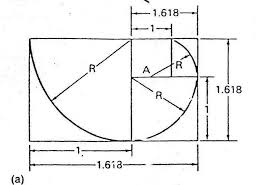
Golden Mean ratio of 1.618

The Golden Mean and the Equilateral Triangle in a Circle; THE CRUCIAL FACT IS THE MIDPOINT OF THE TRIANGLE SIDE
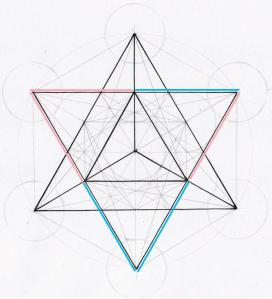
Star Tetrahedron, formed by the MIDPOINTS OF THE CENTRAL EQUILATERAL TRIANGLE (the blue and rose colored lines indicate these midpoint halves)
THEREFORE IT IS PATENTLY OBVIOUS THAT A GOSPEL VERSE AS FUNDAMENTAL AS MATTHEW 16:18 IS BUT A THINLY DISGUISED GLYPH FOR THE TETRAHEDRON, THE QUESTION IS WHY…? AND THE ANSWER IS THAT THE TETRAHEDRON IS THE “TRANS-DIMENSIONAL” FIGURE OF GEOMETRY WHERE ONE DIMENSION CAN TRAVERSE INTO OR INTERSECT ANOTHER DIMENSION. THEREFORE THE CENTRAL TENET OF CHRISTIANITY IN SPIRITUAL ESOTERIC TERMS BEYOND THE “LITERALIST” BIBLE FUNDAMENTALISM, IS THAT THIS REALITY IS SPURIOUS AND UNREAL, A QUANTUM HOLOGRAPH THAT MUST BE TRANSCENDED IN ORDER TO REGAIN A KRYSTOS CONSCIOUSNESS, TO ACCESS THE ETHERIC CRYSTAL LIGHT CONSCIOUSNESS WHICH OPERATES IN MUSICAL HARMONIC MODE –I.E. SYNCHRONICITY–. THE REAL “CHURCH” IS NOT ABOUT REAFFIRMING THIS MATRIX REALITY SIMPLY ADDING A FEW “CORRECTIONS” IN THE MANNER OF MORAL COMMANDMENTS, BUT A FULL DISCLOSURE OF THE NATURE OF THIS SPURIOUS MATRIX REALITY, ITS MEANS OF TRANSCENDING IT, AND THE HARMONIC FREQUENCY PITCH(ES) WHICH MUST BE ATTAINED TO ATTUNE TO THE HIGHER MODE OF CONSCIOUSNESS. THIS IS THE REAL SUPPRESSED GNOSTIC SPIRITUALIZED CHRISTIANITY, AS OPPOSED TO THE MYRIAD OF MERE FUNDAMENTALIST CREEDS PASSING OFF AS THE REAL DEAL, MOST SIMPLY REAFFIRMING THE MATRIX AS TRUE AND ORIGINAL AND DIVINE, ATTEMPTING A LAUGHABLE “LITERALIST” INTERPRETATION OF THE BIBLE –THE BIGGEST OFFENDER OF ALL WOULD CERTAINLY BE THE WATCHTOWER OR JEHOVAH’S WITNESSES IN THIS RESPECT, AS THE MOST LITERALIST/FUNDAMENTALIST AND LEAST SPIRITUAL CULT, BASICALLY JUST A MATERIALIST AUTHORITARIAN THEOCRACY SUPPORTED BY CONTRIVED READINGS OF THE BIBLE IN A LEGALESE MANNER (ALL “LAW” AND “GOVERNMENT” MEMES DEVOID OF ANY SPIRITUAL UNDERSTANDING, A GROSS DISTORTION AND BLATANT MIND CONTROL SOCIAL MANIPULATION OF ESOTERIC GNOSTIC CHRISTIANITY)–.

Tetrahedron in a Circle; AT THE MIDPOINT of the central Equilateral Triangle, the radius connects the center of the circle to the MULTIDIMENSIONAL INTERSECTION POINT AT 19.5 DEGREES ANGLE
“PETER” (is pun of) PERIMETER
“PAUL” (is pun of) POLE
The Tetrahedron opens up to other dimensions at the 19.5 degrees point
|
| Reply |
Message 3 of 3 on the subject |
|
|
|
|
|
|
|
Réponse |
Message 148 de 273 de ce thème |
|
|
|
|
Réponse |
Message 149 de 273 de ce thème |
|
Phi and Geometry
May 14, 2014 by Gary Meisner
Phi (Φ) was described by Johannes Kepler as one of the “two great treasures of geometry.” (The other is the Theorem of Pythagoras.)
Phi appears in many basic geometric constructions.
3 lines:
Take 3 equal lines. Lay the 2nd line against the midpoint of the 1st. Lay the 3rd line against the midpoint of the 2nd. The ratio of AG to AB is Phi, the Golden Ratio. (Contributed by Jo Niemeyer)
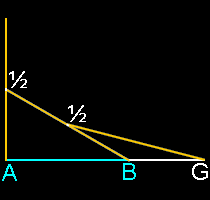
3 sides: Triangle
Insert an equilateral triangle inside a circle, add a line at the midpoint of the two sides and extend that line to the circle. The ratio of AG to AB is Phi.
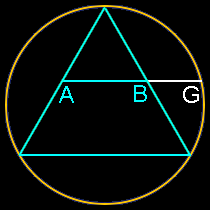
4 sides: Square
Insert a square inside a semi-circle. The ratio of AG to AB is Phi.
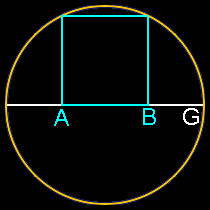
5 sides: Pentagon
Insert a pentagon inside a circle. Connect three of the five points to cut one line into three sections. The ratio of AG to AB is Phi.
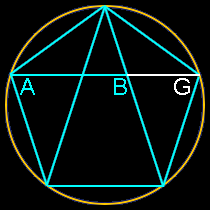
When the basic phi relationships are used to create a right triangle, it forms the dimensions of the great pyramids of Egypt, with the geometry shown below creating an angle of 51.83 degrees, the cosine of which is phi, or 0.618.
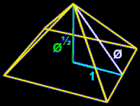
A ruler and compass can be used to construct the “golden rectangle,” as shown by the animations below, which was used by the Greeks in the Parthenon. (See also the Orthogons page.)


Phi also defines other dimensions of a pentagon.
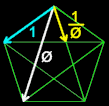
There are also a number of geometric constructions using a circle which produce phi relationships, as shown on the Geometric Construction of Phi in Circles page.
Phi can be related to Pi through trigonometric functions

Note: Above formulas expressed in radians, not degrees
Phi appears in 3D geometric solids
| Take three golden rectangles and assemble them at 90 degree angles to get a 3D shape with 12 corners: |
Click on the shape below and the print the page to do it yourself:
|
|

|
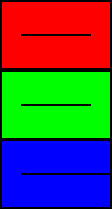
|
This is the basis for two geometric solids
|
| The 12 corners become the 12 centers of each of the 12 pentagons that form the faces of a dodecahedron. |
The 12 corners can also become the 12 points of each of the 20 triangles that form the faces of a icosahedron. |
Dodecahedron
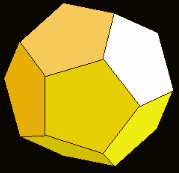
|
Icosahedron
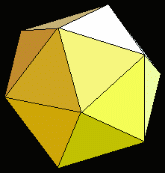
|
| Solid |
Dodecahedron |
Icosahedron |
| Face shape |
Pentagon |
Triangle |
| Faces |
12 |
20 |
| Points |
20 |
12 |
| Edges |
30 |
30 |
|
Some interesting aspects of dodecahedrons and icosahedrons:
A dodecahedron with sides of length 1 embeds a cube with sides of length is Phi.
An icosahedron with sides of length 1, the dual dodecahedron has sides with length 1/Phi. In other words, the dual of the dodecahedron with side of length 1 is an icosahedron with sides of length Phi.
Learn more about phi and geometry on the Penrose Tiling and Quasi-crystals pages.
|
|
|
|
Réponse |
Message 150 de 273 de ce thème |
|
|
|
|
Réponse |
Message 151 de 273 de ce thème |
|
|
|
|
Réponse |
Message 152 de 273 de ce thème |
|
|
|
|
Réponse |
Message 153 de 273 de ce thème |
|
trouble choosing between models — r^2 set:
0.999991869, 0.999987017, 0.999987844, 0.999989971, 0.999992955
so I’ve been looking at physical parameters to help discern
something I noticed:
mass
J / S = 189.9 / 56.846 = 3.34060444
1/(radius^2)
J / S = 0.036962337 / 0.010996863 = 3.361171098
and of course there’s the obvious one we’ve seen pointed out countless times forever:
period:
S / J = 29.447498 / 11.862615 = 2.482378295 ~= 5/2
Given the √5 coming up, notice that
(2 * 2.482378295)^(3/2) = 11.06233845
Of the models based on √5, φ, & 11.06233845 none are uniformly better. Each performs better in a certain segment of the solar system. With r^2 so high, the general pattern is nailed, but even though the residuals are small, they’re sufficiently systematic to demand more scrutinizing attention.
I’m not one to get carried away with details. I like exploring first-order aggregate structure. So I may just report all models side-by-side and leave it there for others to go explore the roots of the subtle but systematic structural nuances. I want to work out and illustrate the geometry before reporting just tables, which are by orders of magnitude inferior to illustrations on the information assimilability scale.
I’m going to rewrite this from above since it’s probably more intuitive reorganized this way:
(φ^5)^(2/3)) ~= 5
2π*5/(2√2) = 2π*5/(2^(3/2)) = 11.10720735
~= φ^5 = 11.09016994
(11.10720735)*(11.09016994) / ( (11.10720735 + 11.09016994) / 2 ) = 11.09868211
2*(11.09868211) = 22.19736421
(1/(J+S)) / (1/(V+E)) = 8.456145629 / 0.380883098 = 22.20141997
5 = 5
2 = 2
φ = 1.61803398874989
1/φ = Φ = 0.618033988749895
2φ = 3.23606797749979
1/2φ = 0.309016994374947
arccos(1/2φ) = 1.25663706143592
(5/2)*arccos(1/2φ) = 3.14159265358979
π = 3.14159265358979
2π = 6.28318530717959
2π/5 = 1.25663706143592
cos(2π/5) = 0.309016994374947
1/cos(2π/5) = 3.23606797749979
2cos(2π/5) = 0.618033988749895
1/(2cos(2π/5)) = 1.61803398874989
1/(2cos(2π/5)) = φ
(5/2)*arccos(1/2φ) = π
|
|
|
 Premier Premier
 Précédent
139 a 153 de 273
Suivant Précédent
139 a 153 de 273
Suivant Dernier
Dernier
|
|
| |
|
|
©2025 - Gabitos - Tous droits réservés | |
|
|








![]()





















